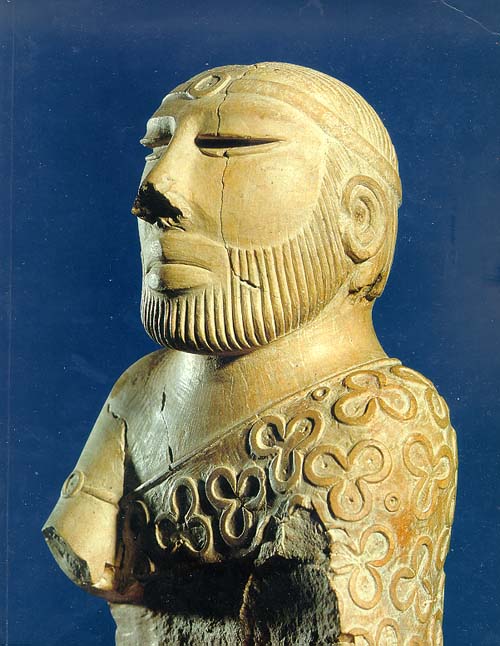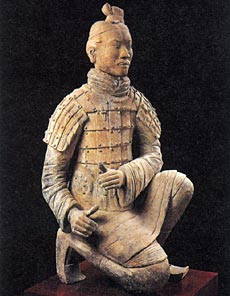Mohenjo-daro Man
I thought I had a really clever idea for B's late Christmas present. Since she got her first A+ in Archaeology, I would take a leisurely stroll down to the Met and buy her a repro Mohenjo-daro figurine -- of the priest-king, I was thinking. This Guy.

Why did I think the Met must sell reproductions of this famous man? First, because he's famous - and iconic, as far as I know. Second, because the Met is omniscient, as far as I know, and the stores are still full of voracious shoppers so Mohenjodaro repros must yet be in stock. Third, because I could have sworn I saw something similar among the Assyrian exhibits, which of course is not the same thing, but I figured if they didn't reproduce the good priest-king, then an Assyrian figurine would do to suggest Mohenjo-daro or Harappa in a pinch....
So first, I combed the regular gift shops downstairs, then I ran up and down and around and around the Met. One saleswoman on the kids' floor said she'd never heard of Harappa, and if there was anything about archaeology in India in the shop, she would know about it. She pointed out a board game or some such thing, based on the mausoleum of Emperor Qinshihuang. When I said "No, thanks," she thanked me instead for telling her about Harappa. I tried a young salesman who seemed to be Desi, and although I realized he might have been Born Confused, I was surprised to hear he had never heard of Mohenjo-daro either.
Upstairs, I pushed through huge crowds on the main balcony who had come to catch the last day of the Van Gogh exhibit and all the reliquaries from Prague, to the nearly empty South and South East Asian Wing and hurried past all the statues of Gautama, looped back past the Korean statuary, and found a tiny gift sales counter. There, I scoped the few books and cards and turned to the saleswoman, who said, "There really isn't anything here about Asia at all, is there? I'm from the Phillipines and it makes me very sad." I pushed back through the crowds to the Islamic section, where I figured someone might have placed yet another gift shop. I scurried past a few vitrines displaying seals and ceramics excavated from West Asia, and past all the seventeenth century art that seemed to come next, and came across a guard, who said, "Gift shop? Yeah, sure, there's one over by the Impressionists if you go all the way down this hall and take a right, but no, I guess there isn't one for this section-- you know? I never thought of that!"
At the Asia Society, there was nothing at all on Mohenjo-daro or Harappa, but there were resin Buddha statues in primary colors-- neither here nor there in terms of my quest, but sort of hip - although monstrously expensive to buy in three colors, as I did in my mind's eye.
I gave up, went back, and bought B a beautiful book about the Ajanta Caves that I had seen earlier at the Met bookstore, with photography by Benoy Behl, who used long exposures and natural light to create luminous images. Then, I went down to Pearl River Mart on Broadway, where I found replicas of Emperor Qinshihuang's guards, and chose a large, kneeling figure of a Qin terracotta soldier, quite grown up, for B. A couple of millenia off, no doubt, but still and all, my feet were killing me.

Came home and watched Fellini's Casanova on tv --much more convincing, although not based on the man's own supposedly deadly dull diaries. Here was a lavish production indeed -- all those chandeliers coming down, down, to be fanned out by a cadre of uniformed and bewigged chandelier extinguishers who frog-marched out on barked orders afterwards, the crazy court, the terrible doll, each frame an extraordinary composition with eeriest lighting, the unforgettable golden coach carrying away his witchy old unfeeling mamma. Donald Sutherland with a nose job, a spooky, ever-receding hairline, or a wigline, the monstrosity of old age inthe eighteenth century, and hardly any need to talk. Properly depraved and detatched, the action interspersed with dry, brutal, manic climaxes.... Italian and German courts and coach houses depicted and the close relationship of the cultures conveyed with the weight of knowledge -- all of it intensely atmospheric, too.

Why did I think the Met must sell reproductions of this famous man? First, because he's famous - and iconic, as far as I know. Second, because the Met is omniscient, as far as I know, and the stores are still full of voracious shoppers so Mohenjodaro repros must yet be in stock. Third, because I could have sworn I saw something similar among the Assyrian exhibits, which of course is not the same thing, but I figured if they didn't reproduce the good priest-king, then an Assyrian figurine would do to suggest Mohenjo-daro or Harappa in a pinch....
So first, I combed the regular gift shops downstairs, then I ran up and down and around and around the Met. One saleswoman on the kids' floor said she'd never heard of Harappa, and if there was anything about archaeology in India in the shop, she would know about it. She pointed out a board game or some such thing, based on the mausoleum of Emperor Qinshihuang. When I said "No, thanks," she thanked me instead for telling her about Harappa. I tried a young salesman who seemed to be Desi, and although I realized he might have been Born Confused, I was surprised to hear he had never heard of Mohenjo-daro either.
Upstairs, I pushed through huge crowds on the main balcony who had come to catch the last day of the Van Gogh exhibit and all the reliquaries from Prague, to the nearly empty South and South East Asian Wing and hurried past all the statues of Gautama, looped back past the Korean statuary, and found a tiny gift sales counter. There, I scoped the few books and cards and turned to the saleswoman, who said, "There really isn't anything here about Asia at all, is there? I'm from the Phillipines and it makes me very sad." I pushed back through the crowds to the Islamic section, where I figured someone might have placed yet another gift shop. I scurried past a few vitrines displaying seals and ceramics excavated from West Asia, and past all the seventeenth century art that seemed to come next, and came across a guard, who said, "Gift shop? Yeah, sure, there's one over by the Impressionists if you go all the way down this hall and take a right, but no, I guess there isn't one for this section-- you know? I never thought of that!"
At the Asia Society, there was nothing at all on Mohenjo-daro or Harappa, but there were resin Buddha statues in primary colors-- neither here nor there in terms of my quest, but sort of hip - although monstrously expensive to buy in three colors, as I did in my mind's eye.
I gave up, went back, and bought B a beautiful book about the Ajanta Caves that I had seen earlier at the Met bookstore, with photography by Benoy Behl, who used long exposures and natural light to create luminous images. Then, I went down to Pearl River Mart on Broadway, where I found replicas of Emperor Qinshihuang's guards, and chose a large, kneeling figure of a Qin terracotta soldier, quite grown up, for B. A couple of millenia off, no doubt, but still and all, my feet were killing me.

Came home and watched Fellini's Casanova on tv --much more convincing, although not based on the man's own supposedly deadly dull diaries. Here was a lavish production indeed -- all those chandeliers coming down, down, to be fanned out by a cadre of uniformed and bewigged chandelier extinguishers who frog-marched out on barked orders afterwards, the crazy court, the terrible doll, each frame an extraordinary composition with eeriest lighting, the unforgettable golden coach carrying away his witchy old unfeeling mamma. Donald Sutherland with a nose job, a spooky, ever-receding hairline, or a wigline, the monstrosity of old age inthe eighteenth century, and hardly any need to talk. Properly depraved and detatched, the action interspersed with dry, brutal, manic climaxes.... Italian and German courts and coach houses depicted and the close relationship of the cultures conveyed with the weight of knowledge -- all of it intensely atmospheric, too.

<< Home